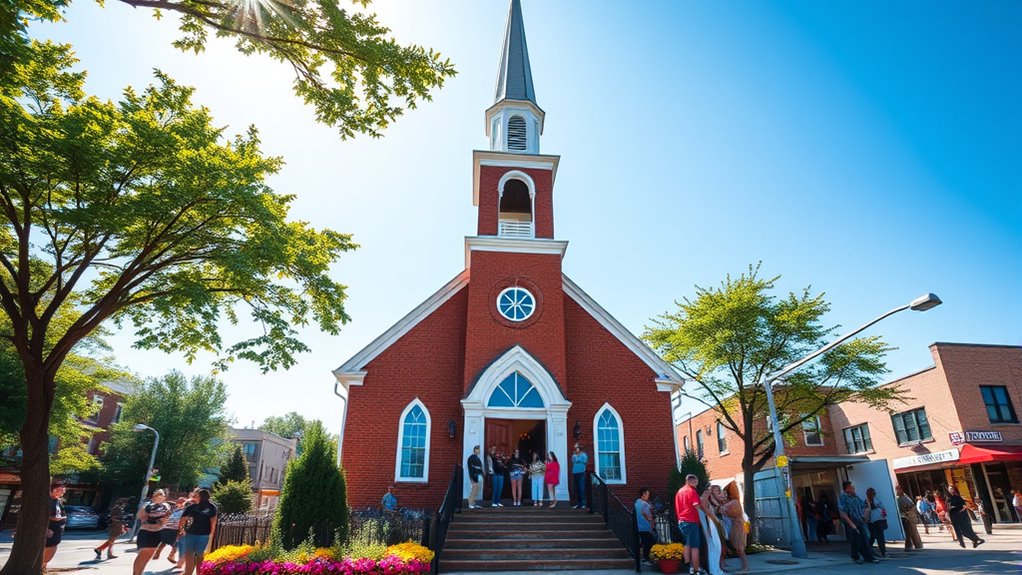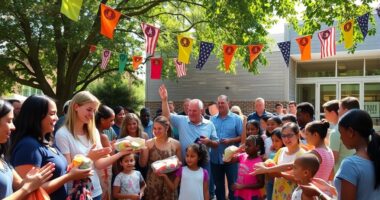As a church, you can serve your community by building genuine relationships with neighbors, understanding their needs, and offering practical support like food drives, outreach programs, and events. Partnering with local organizations and leaders helps expand your impact and shows your commitment. Creating inclusive and accessible spaces makes everyone feel welcome. If you keep exploring, you’ll discover how to effectively reach neighbors with hope, grace, and meaningful service.
Key Takeaways
- Churches serve their communities through faith-based initiatives like food drives, education, and housing support, demonstrating a genuine commitment beyond Sunday services.
- Building trust involves consistent engagement, active listening, and culturally sensitive outreach to foster meaningful neighbor relationships.
- Creating inclusive spaces with accessible design and diverse cultural representation ensures everyone feels welcomed and valued.
- Conducting community needs assessments and collaborating with local organizations help churches tailor programs to address specific local challenges.
- Partnering with community leaders and volunteers amplifies outreach efforts, making service efforts more targeted and impactful.
Understanding the Role of Churches in Community Life
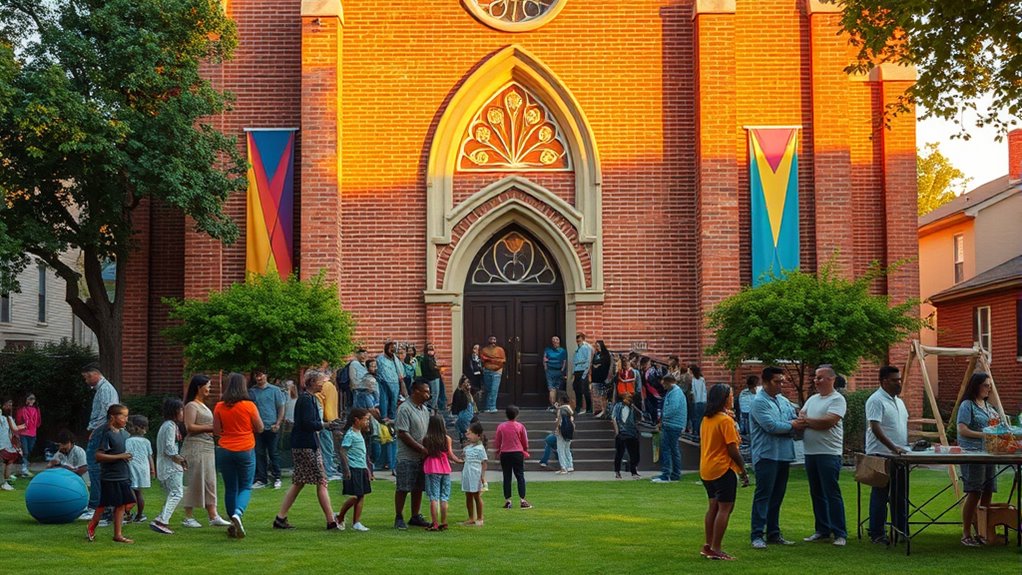
Churches play a crucial role in shaping the fabric of their communities by providing more than just spiritual guidance. They actively engage in faith-based initiatives that address local needs, such as food drives, housing support, and educational programs. These efforts demonstrate a commitment to improving lives beyond Sunday services. Spiritual outreach is a vital part of this involvement, allowing you to connect with neighbors and offer hope and compassion. By mobilizing volunteers and resources, churches become hubs of support and community development. Your church’s efforts foster a sense of belonging and trust, making it easier for people to seek help and grow spiritually. Additionally, understanding the importance of projector image quality, such as contrast ratio and color accuracy, can help churches create inviting environments for community events and gatherings. Paying attention to venue lighting and audiovisual quality can further enhance the comfort and engagement of attendees. Incorporating high-quality visual displays can also improve communication during outreach activities and presentations. Furthermore, utilizing organic and natural juices during community events can promote healthier lifestyles and demonstrate a holistic approach to well-being. Incorporating reliable resources and accurate information about community needs can strengthen the impact of outreach programs and foster lasting relationships. Through these initiatives, you help build resilient neighborhoods rooted in faith and mutual care.
Building Genuine Relationships With Neighbors
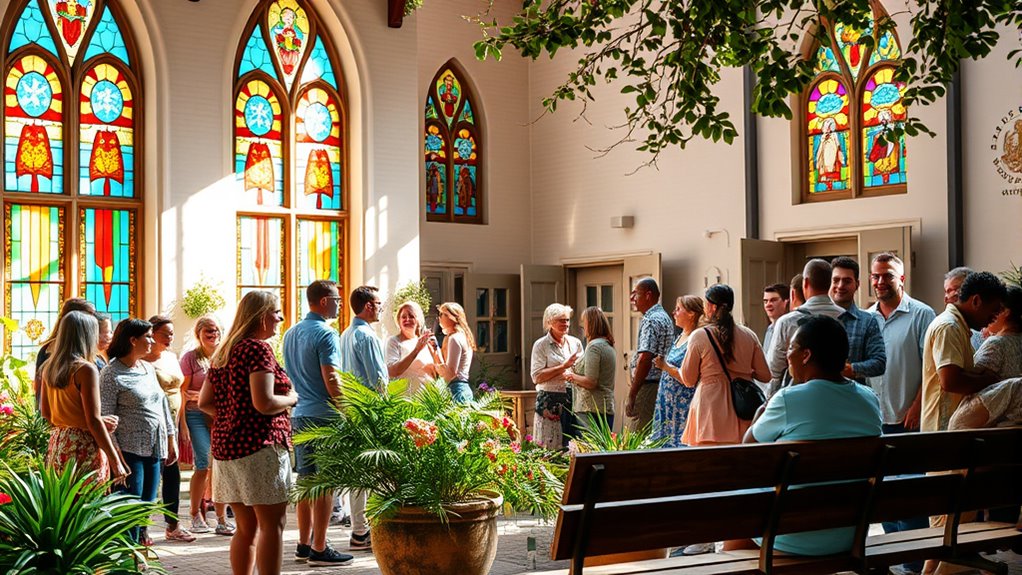
To build genuine relationships with your neighbors, you need authentic engagement strategies that show you truly care. Being consistently present in the community helps foster trust and familiarity over time. When you make an effort to connect sincerely, you’ll find meaningful bonds naturally develop. Recognizing and understanding aura variations can also deepen your awareness of others’ emotional and spiritual states, enhancing your ability to connect genuinely. Developing empathy skills can further strengthen these connections by allowing you to respond more compassionately to others’ needs. Additionally, paying attention to community feedback can guide your efforts to serve more effectively. You might also consider selecting dog names that reflect the personality or background of your community members, creating an additional layer of connection. Incorporating thoughtful gestures like sharing natural sweeteners such as honey can also create opportunities for conversation and connection.
Authentic Engagement Strategies
Building genuine relationships with neighbors requires intentionality and genuine interest. One effective strategy is to engage in faith-based initiatives that foster trust and shared values. Organize community events or spiritual outreach programs that invite participation without pressure, creating opportunities for authentic connection. Show up consistently and listen actively to understand their needs and concerns. Your sincerity in these efforts demonstrates that your church cares beyond just attendance. By partnering with neighbors through service projects or prayer groups, you build a foundation of trust and respect. Remember, authentic engagement isn’t about quick fixes; it’s about nurturing real relationships grounded in compassion, faith, and shared purpose. Incorporating community-oriented activities can further enhance your outreach efforts and demonstrate your church’s commitment to the neighborhood. These strategies help your church become a trusted presence in the community, opening doors for meaningful spiritual conversations while emphasizing the importance of trust-building as a core element of effective outreach. Additionally, understanding the diverse backgrounds and interests of your neighbors can help tailor your engagement efforts to be more inclusive and effective, especially as research shows that music therapy can be an effective tool in fostering emotional well-being and connection. Exploring cultural sensitivities further ensures your outreach is respectful and inclusive.
Consistent Community Presence
Establishing a consistent community presence requires intentional effort and ongoing commitment. By regularly engaging with neighbors, you build trust and foster genuine relationships rooted in faith practices. This consistency creates opportunities for spiritual growth—for both you and your community. Additionally, incorporating community outreach initiatives can further demonstrate your church’s active role in addressing local needs and concerns. Maintaining a visible and approachable presence helps reinforce the church’s role as a caring neighbor and a vital part of the community fabric. Understanding the importance of local engagement can help deepen these relationships and expand your church’s positive impact. Utilizing cookie consent management tools ensures respectful and transparent engagement with visitors, enhancing trust and communication. Using self watering plant pots as a metaphor for consistent nurturing can also inspire ongoing care and attention within community relationships.
Identifying Community Needs and Opportunities
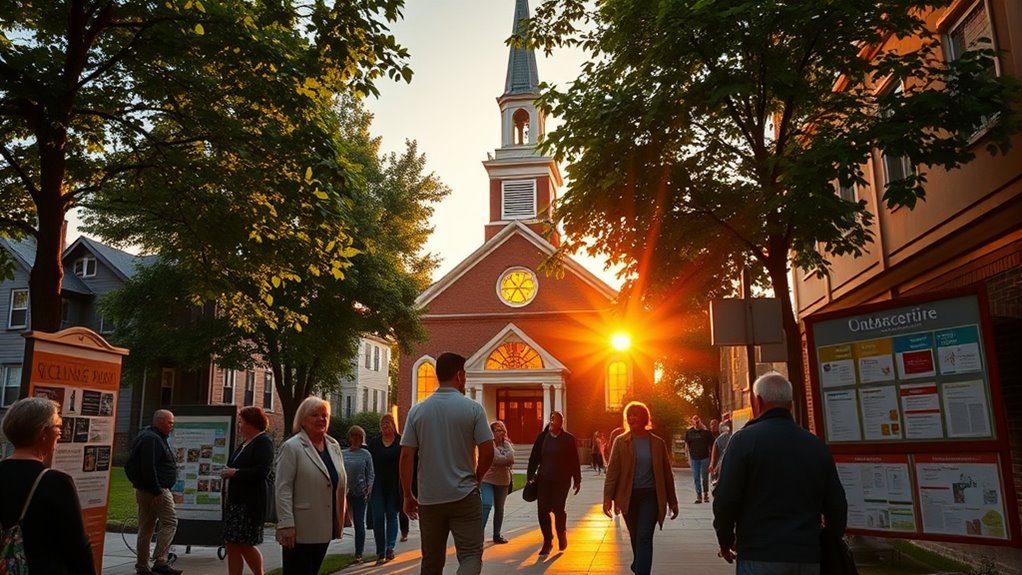
How can your church effectively identify the real needs and opportunities within the community? Start by conducting neighborhood surveys to gather direct feedback from residents. These surveys reveal pressing issues, resources, and gaps you might not notice otherwise. Additionally, collaborating with local businesses can provide valuable insights—they often understand community trends and concerns firsthand. Engage business owners and employees in conversations or joint meetings to uncover shared needs. Pay attention to patterns and recurring themes from these sources. Visiting local events and talking with community members also helps you understand their priorities. By combining data from surveys, partnerships, and casual interactions, your church can accurately identify where to focus its efforts and how to serve effectively. Observing celebrity lifestyle trends can also inspire innovative outreach ideas that resonate with different community segments. Incorporating powerful persuasive words into your messaging can further enhance your outreach efforts and foster stronger connections within the community. Furthermore, understanding the evolving AI capabilities and their societal impacts can help tailor your outreach and engagement strategies to meet contemporary challenges and opportunities. Being aware of community needs and how they change over time ensures your church remains responsive and relevant. Additionally, analyzing local demographic data can help pinpoint specific groups that might benefit most from your programs.
Organizing Outreach Programs and Events
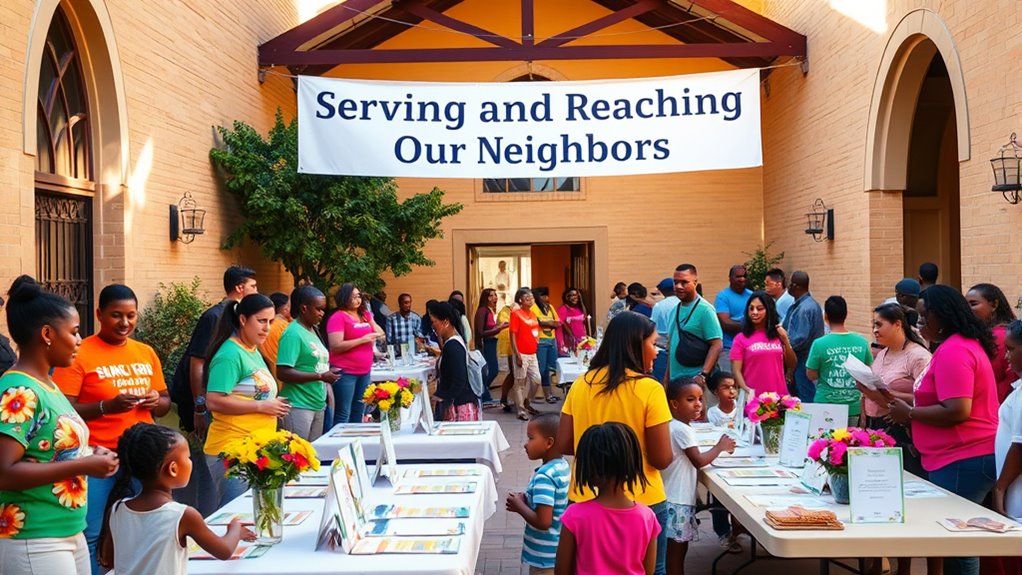
Once you’ve identified the community’s needs and opportunities, organizing outreach programs and events becomes a powerful way to make a tangible impact. Focus on effective event planning by setting clear goals, choosing accessible locations, and engaging volunteers. During these events, prioritize resource distribution, ensuring essentials like food, clothing, and informational materials reach those who need them most. Keep communication simple and direct to encourage participation. Coordinate logistics carefully—promote the event through various channels and prepare materials ahead of time. Remember, well-organized events build trust and demonstrate your church’s commitment to serving the community. Additionally, understanding the hours today for local retail stores can help you plan the logistics and resource distribution more effectively. By combining thoughtful event planning with strategic resource distribution, you create meaningful opportunities to meet needs and foster lasting relationships with your neighbors.
Partnering With Local Organizations and Leaders
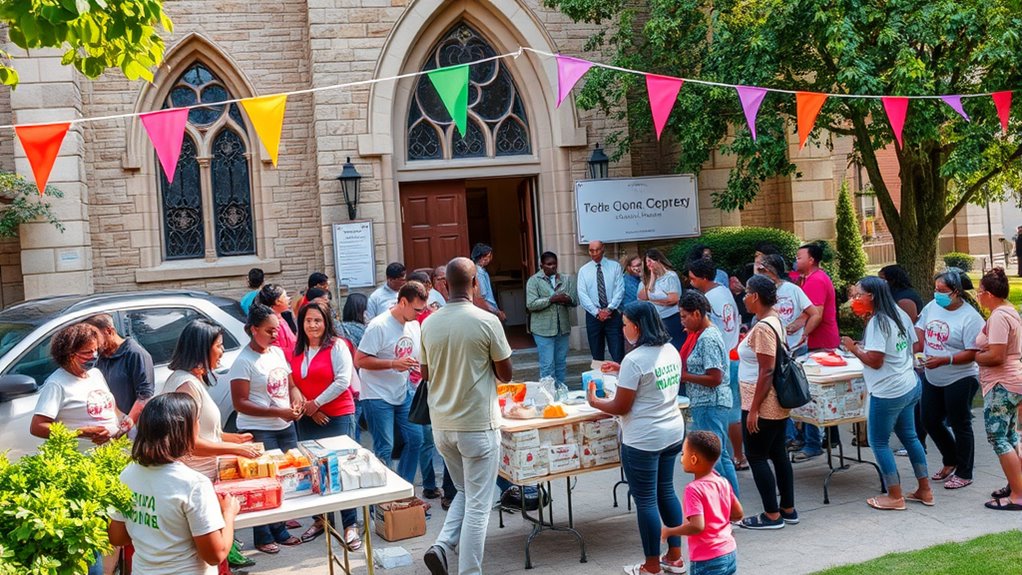
Partnering with local organizations and leaders amplifies your church’s outreach efforts and guarantees your initiatives meet genuine community needs. By engaging in collaborative initiatives, you combine resources, expertise, and networks, making your efforts more effective. These partnerships foster trust and demonstrate your church’s commitment to the community’s well-being. Resource sharing allows both parties to maximize their impact without duplicating efforts, saving time and funds. When you work alongside local schools, nonprofits, and government agencies, you tap into existing channels and insights, making your outreach more targeted and relevant. Building strong relationships with community leaders helps your church stay informed about pressing issues and opportunities, ensuring your outreach remains meaningful and responsive to the community’s evolving needs.
Volunteering: Making a Hands-On Difference
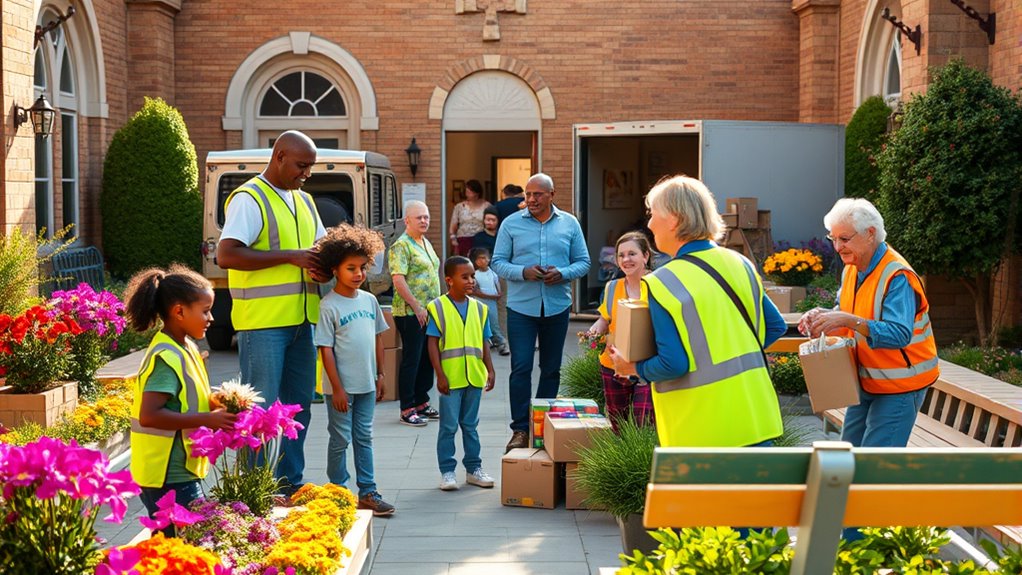
When you volunteer, you can build meaningful personal connections with others in your community. Your hands-on efforts directly address local needs and make a real impact. By getting involved, you not only help those around you but also strengthen the fabric of your community.
Building Personal Connections
Have you ever noticed how volunteering can create instant bonds within a community? Sharing personal stories during service helps neighbors connect on a deeper level, fostering understanding and trust. It also enhances cultural awareness, allowing you to appreciate diverse backgrounds and traditions. These connections turn simple acts into meaningful relationships, strengthening your community’s fabric. To build these bonds, consider the following ideas:
| Action | Example | Impact |
|---|---|---|
| Share personal stories | Talk about your experiences | Builds trust and empathy |
| Celebrate cultural events | Attend multicultural festivals | Promotes understanding |
| Listen actively | Hear neighbors’ stories and needs | Creates genuine connections |
| Volunteer regularly | Consistent presence in community projects | Fosters lasting bonds |
Addressing Community Needs
Volunteering allows you to make a tangible difference by directly addressing the needs of your community. Through faith-based initiatives, you can offer support rooted in compassion and shared values. Partnering with local organizations in social service collaborations guarantees your efforts reach those who need help most. Whether distributing food, mentoring youth, or assisting with housing, your hands-on involvement shows neighbors they’re cared for. By engaging in these activities, you help bridge gaps and strengthen community bonds. Your active participation demonstrates that faith isn’t just personal but also a call to serve others. Together, these efforts create a ripple effect, fostering hope and resilience in your neighborhood. Your commitment makes a lasting impact, showing that real change begins with your willingness to serve.
Creating Inclusive and Accessible Spaces

Creating inclusive and accessible spaces is essential for fostering a welcoming environment where everyone feels valued and respected. By prioritizing accessible design, you guarantee that individuals with mobility challenges or sensory needs can comfortably participate in church activities. Incorporate features like ramps, wide doorways, and clear signage to remove physical barriers. Cultural inclusivity also plays a vital role—consider diverse backgrounds and traditions when planning your space, and display symbols or artifacts that reflect different cultures. This approach shows your community that all are embraced and celebrated. When your church is both accessible and culturally inclusive, you create a space where everyone can connect, grow, and feel genuinely welcomed, strengthening your community’s unity and spiritual journey.
Sharing the Message of Hope and Grace
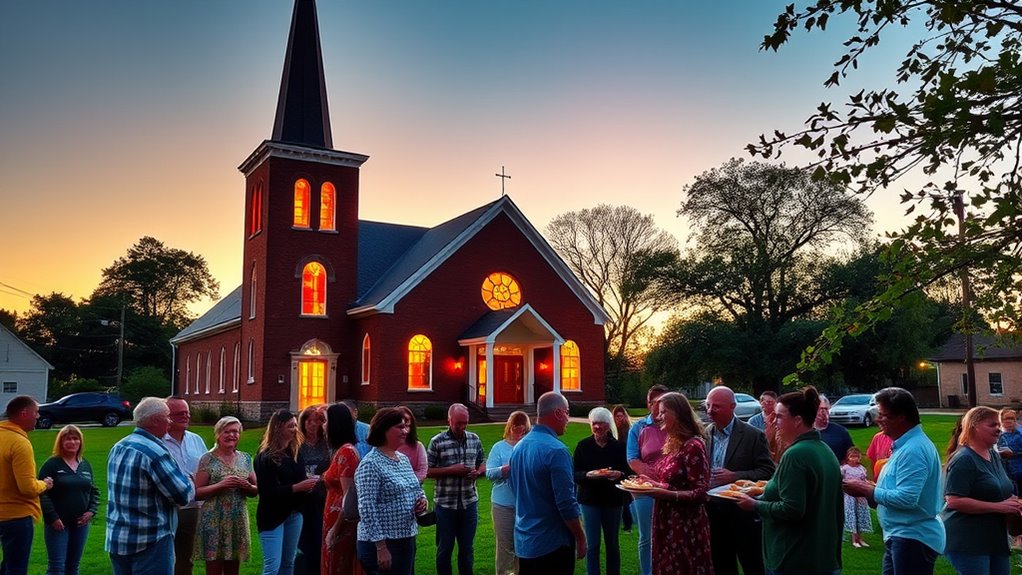
Sharing the message of hope and grace builds on creating inclusive and accessible spaces by reminding everyone that they are valued and loved beyond physical barriers. Your faith outreach can be a powerful tool to spread grace sharing, showing others that salvation and compassion are available to all. Imagine this:
| Light | Heart | Community |
|---|---|---|
| Acts of kindness | Words of encouragement | United in faith |
| Open doors | Listening ears | Hands reaching out |
| Hope igniting | Grace flowing | Lives transformed |
Evaluating and Growing Your Community Engagement

To effectively grow your community engagement, it’s essential to regularly evaluate the impact of your efforts and seek ways to improve. Review how your faith-based initiatives resonate with neighbors and identify areas for enhancement. Gather feedback from those you serve through surveys or casual conversations to understand their needs better. Track participation in your spiritual outreach programs to see what’s working and where engagement can grow. Use this information to refine your strategies, introduce new initiatives, or deepen existing ones. Consistent assessment ensures your efforts stay relevant and impactful, fostering stronger connections. By intentionally evaluating and adjusting your approach, you create a dynamic community presence that genuinely serves and reaches your neighbors effectively.
Frequently Asked Questions
How Can I Personally Invite Neighbors to Church Events Comfortably?
You can comfortably invite neighbors to church events by focusing on building a personal connection first. Use simple invitation strategies like mentioning the event casually or sharing why it’s meaningful to you. Offer to go together or help with transportation. Keep your tone friendly and genuine, showing that you care about their interests. This approach makes your invitation feel natural and less intimidating, encouraging them to join you.
What Are Effective Ways to Engage Youth and Children in Community Outreach?
To effectively engage youth and children in community outreach, you should focus on youth engagement through fun, interactive activities that resonate with their interests. Organize children activities that promote teamwork and creativity, making participation enjoyable. You can also involve older youth as leaders, encouraging peer-to-peer connection. By creating a welcoming environment and offering meaningful opportunities, you’ll inspire their active involvement and foster a sense of community among young participants.
How Does a Church Determine Which Community Issues to Prioritize?
When deciding which community issues to prioritize, you should conduct a community assessment to understand local needs and challenges. Use the assessment to identify pressing issues that align with your church’s strengths and values. Engage with community members for input and feedback, ensuring your issue selection genuinely reflects their needs. This approach helps you focus on impactful efforts, fostering trust and meaningful change in your neighborhood.
What Resources Are Available to Churches for Starting Outreach Programs?
Ever wonder what resources can jump-start your outreach programs? You can access volunteer training to equip your team effectively and seek outreach funding from local grants, church budgets, or donations. Many organizations also offer free toolkits, guides, and workshops to help you plan and execute your ideas. These resources make it easier to serve your community and make a meaningful impact right where you are.
How Can Churches Sustain Long-Term Relationships With Community Partners?
To sustain long-term relationships with community partners, you should focus on building trust through consistent, transparent communication. Engage in collaborative planning by involving partners in decision-making and goal-setting, which fosters mutual investment. Regularly evaluate and adapt your efforts to meet evolving community needs. By maintaining openness and shared responsibility, you create strong, lasting partnerships that benefit everyone and deepen your church’s positive impact in the neighborhood.
Conclusion
By engaging actively in your community, you can make a real difference. Did you know that neighborhoods with strong church involvement see 25% higher levels of trust and cooperation? When you build genuine relationships, identify needs, and serve with love, you help create a more connected, compassionate community. Keep growing, partnering, and sharing hope—your efforts can transform lives and inspire others to join in making a lasting impact.

